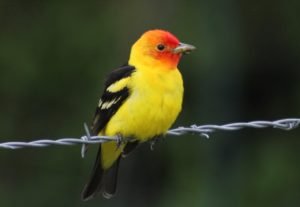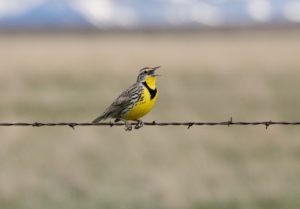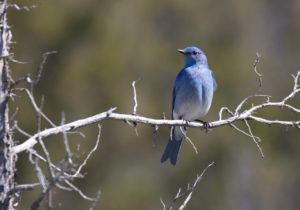Uncategorized
Back 40: Identifying Big Sky’s birds
Published
6 years agoon
Posted By
Outlaw Partners

By Jessianne Wright EBS Contributor
This April, many birds will return to the alpine terrain of Big Sky. Some species simply move from higher to lower elevations on the mountains, while others travel thousands of miles from winter feeding grounds to summer breeding grounds.
EBS spoke with Lou Ann Harris, a member of Bozeman’s Sacajawea Audubon Society, to learn more about a selection of migratory birds that are returning to Gallatin County. Here is what she had to say.
Mountain BluebirdWingspan: 12 inches
Weight: 1.1 ounces
Against the backdrop of a dull, brown Montana landscape, the blue flash of a male mountain bluebird is a welcome sign of spring. The mountain bluebird winters in New Mexico and Texas and begins its spring migration early, with the males arriving in late February or early March.
Once the male establishes his breeding territory, he waits for a female to come around, courting her by singing, flight displays or offers of food. Female bluebirds select a mate based on the location and quality of the nesting cavity he offers her, not on his appearance or singing ability.
The mountain bluebird’s diet consists mostly of insects, with a preference for caterpillars and grasshoppers. In the winter and early spring, they will eat small fruits, seeds and earthworms. The birds use a foraging technique called “sallying” in which they fly down from a perch to snatch an insect on the ground, returning to a perch to eat.
Bluebirds are secondary cavity nesters, meaning they use old woodpecker holes to nest. In the absence of natural cavities, they will use manmade nest boxes.
Sacajawea Audubon members maintain and monitor over 300 bluebird boxes in Gallatin County and also band nestlings and adult females. Recaptures of banded bluebirds show that the same birds return every year to the same nesting territories and sometimes to the exact same nest box.


The Western tanager gets its scarlet head feathers from a rare pigment called rhodoxanthin, which likely comes from insects. PHOTO BY JOHN HARRIS
Wingspan: 11.5 inches
Weight: 0.98 ounces
There are not very many birds that breed in Montana that can beat the Western tanager for its sheer gaudy plumage.
The male sports a bright yellow body, an orange-red head and black wings, back and tail. The female is more understated, with a gray back and greenish-yellow rump and nape.
They primarily eat insects during the nesting season, especially wasps, grasshoppers, beetles and dragonflies. Before swallowing dragonflies, the birds clip off the bug’s wings, and sometimes the legs and head as well.
This long-distance migrant spends its winters in Mexico and Central America. It migrates north at night, usually alone or in small flocks.
Western tanagers range farther north than any other tanager, breeding northward to a latitude of 60 degrees, where they spend as little as two months before migrating south. In Montana, these birds nest in open coniferous forests.
The song of the Western tanager is reminiscent of an American robin, but shorter and raspier in tone.


John James Audubon gave the Western meadowlark it’s scientific name (Sturnella neglecta), claiming that most Western explorers and settlers overlooked this common bird. PHOTO BY LOU ANN HARRIS
Wingspan: 16 inches
Weight: 3.6 ounces
The flutelike song of the Western meadowlark, Montana’s state bird, is always a welcome sound in the spring. This chunky robin-sized songbird is often more easily heard than seen.
The meadowlark is a bird of native grasslands, prairies and agricultural fields.
It is a colorful member of the blackbird family, with a bright yellow breast crossed with a black “v.”
Meadowlarks are ground nesters. The female uses her bill to shape a cup-like depression in the soil, often using an animal’s footprint to start. She then lines the hole with soft, dry grasses and pliable stems. She will sometimes create a waterproof dome over the nest by weaving together grass and shrub stems. This will take her 6-8 days to complete.
Meadowlarks are varied in their diet. They will forage for grain in winter and early spring, insects in late spring and summer, and weed seeds in the fall. During hard winters, they may even feed on roadkill.
Like other blackbirds, meadowlarks use a feeding behavior called “gaping.” This involves inserting their bill into the soil and forcing it open to create a hole, giving them access to insects that most birds can’t reach.
Lou Ann Harris is a member of the Sacajawea Audubon Society in Bozeman and has been an avid bird lover since 1997. She honed her birding skills in Washington state, learning to identify most species by their calls and songs. Sacajawea Audubon hosts numerous bird-related events, classes and field trips. For more information, visit sacajaweaaudubon.org.
The Outlaw Partners is a creative marketing, media and events company based in Big Sky, Montana.


Upcoming Events
april, 2024
Event Type :
All
All
Arts
Education
Music
Other
Sports
Event Details
We all are familiar with using a limited palette, but do you use one? Do you know how to use a
more
Event Details
We all are familiar with using a limited palette, but do you use one? Do you know how to use a limited palette to create different color combinations? Are you tired of carrying around 15-20 different tubes when you paint plein air? Have you ever wanted to create a certain “mood” in a painting but failed? Do you create a lot of mud? Do you struggle to achieve color harmony? All these problems are addressed in John’s workbook in clear and concise language!
Based on the bestselling “Limited Palatte, Unlimited Color” workbook written by John Pototschnik, the workshop is run by Maggie Shane and Annie McCoy, accomplished landscape (acrylic) and plein air (oil) artists,exhibitors at the Big Sky Artists’ Studio & Gallery and members of the Big Sky Artists Collective.
Each student will receive a copy of “Limited Palette, Unlimited Color” to keep and take home to continue your limited palette journey. We will show you how to use the color wheel and mix your own clean mixtures to successfully create a mood for your paintings.
Each day, we will create a different limited palette color chart and paint a version of a simple landscape using John’s directives. You will then be able to go home and paint more schemes using the book for guidance.
Workshop is open to painters (oil or acrylic) of any level although students must have some basic knowledge of the medium he or she uses. Students will be provided the book ($92 value), color wheel, value scale and canvas papers to complete the daily exercises.
Sundays, April 14, 21 and 28, 2024
Noon until 6PM.
$170.
Time
14 (Sunday) 12:00 pm - 28 (Sunday) 6:00 pm
Event Details
Trivia from 7 to 9 p.m. at The Waypoint in Town Center. Participation is free, food and beverages available.
Event Details
Trivia from 7 to 9 p.m. at The Waypoint in Town Center. Participation is free, food and beverages available.
Time
(Wednesday) 7:00 pm - 9:00 pm
Location
The Waypoint
50 Ousel Falls Rd











